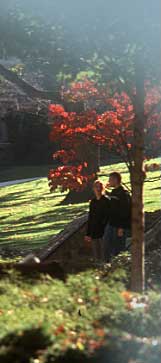
| LEHIGH HOME | SEARCH |
|
 |
|
||||||||
 |
|
||||||||||||
|
|||||||||||||
|
Kishore recognized as one of nation’s top young engineers
Shalinee Kishore, whose research focuses on wireless networks in rural areas, was honored in a White House ceremony.
In a ceremony on June 13 at the White House, Kishore and 57 of her peers from around the nation received the 2004 Presidential Early Career Award for Scientists and Engineers (PECASE) from President George W. Bush. Kishore, who aims to use wireless networks to provide rural areas with Internet and cell phone access, is one of 20 PECASE winners nominated by the National Science Foundation (NSF). The remaining 38 recipients were nominated by eight other federal agencies, including NASA, the Department of Defense, the Department of Energy and the National Institutes of Health. The awards ceremony was presided over by John H. Marburger III, science advisor to President Bush and director of the White House Office of Science and Technology Policy. Bringing wi-fi to rural America
Nominees for the PECASE award are chosen from among the 350 to 400 young professors in the U.S. who typically receive NSF’s Faculty Early Career Program (CAREER) Award during the year the PECASE award is given. Monetary support for CAREER Awards ranges from $400,000 to almost $1 million over five years. Kishore received a CAREER Award from NSF in December 2003 to study multitier wireless networks and demonstrate their usefulness in remote, under-served regions by developing an outreach program with Susquehanna County in northern Pennsylvania. Multitier wireless networks contain components (base stations and/or user terminals) whose coverage areas can vary in their order magnitude. The multitier wireless networks that Kishore is designing can simultaneously provide ubiquitous low-rate coverage (for cell phones) and targeted high-speed Internet access through a network of base stations and user terminals. Last summer, Kishore held a seven-day workshop in Susquehanna County to explain the principles of wireless communications and to help residents develop ideas for adapting the technology to the county’s unique communications needs. To demonstrate its benefits, she, her students and county residents set up a wi-fi (wireless local area network) demonstration at the county’s annual Blueberry Festival. Susquehanna County’s rugged terrain is not hospitable to the laying of cable and wires. The county lacks adequate cellular coverage and high-speed Internet access as well as reliable 9-1-1 services. One of the county’s six high schools has wi-fi Internet access, but overall, the county lacks localized broadband access, and its existing wireless links are poor. The county’s low population density gives providers of Internet services little incentive to install the wires necessary for digital or cable-modem access. Optimizing scarce bandwidth One of Kishore’s goals is to determine how to provide the maximum amount of wireless signal coverage with the minimum number of base stations, or transmitting and receiving stations. In identifying the optimal wireless communication infrastructure for the county, she will take into consideration the demographics of the region, including the communication needs of county residents. To this end, two of Kishore’s students—Andrew Reid ’06, an electrical engineering major, and Dimitri Demergis ’04, a graduate student in electrical engineering—are compiling a radio contour map of Susquehanna County. The color-graded map will show which geographical regions of the county, based on the location of hills, mountains and other topographical features, currently have high or low radio signal coverage. To obtain this map, Reid and Demergis will drive around Susquehanna County and use spectrum analyzers and GPS measurement devices to collect data. They will also use results from sophisticated radio propagation software packages. Three Ph.D. candidates studying with Kishore—Yan Li, Zhenlei Shen and Yingda Chen—are conducting theoretical research on the design and performance of multitier wireless networks. Demergis and Reid will use their fundamental results to design an adequate wireless network for Susquehanna County. Kishore is also collaborating with Rosemary Berger, assistant professor of industrial and systems engineering, to determine how to design and lay out an optimal network of base stations. This research will be helpful for not only residents of Susquehanna County but other rural communities as well. The two professors plan to design an online software tool that rural residents and service providers can use to evaluate the capacity and coverage offered by a wireless network design. The software will also aid in designing optimal network architectures based on demographic needs and topographic constraints. Kishore’s goal in all these research efforts is to optimize scarce bandwidth and minimize interference caused by reuse of the bandwidth spectrum across tiers. Her approach, she says, represents “a novel and expansive study of spectrally efficient multitier architectures.” --Kurt Pfitzer Posted on Monday, June 20, 2005 |
|||||||||||||||||||||||||||||||||||||||||||
 |
||||||||||||||||||||||||||||||||||||||||||||
|
|
|||||||||
|
|
|
|
|